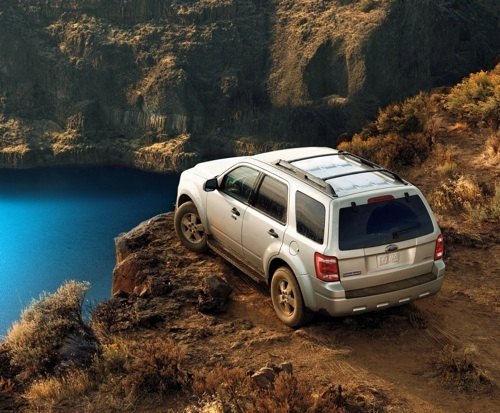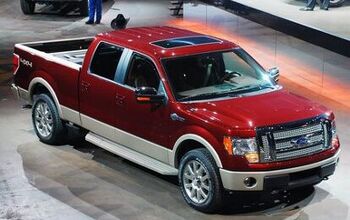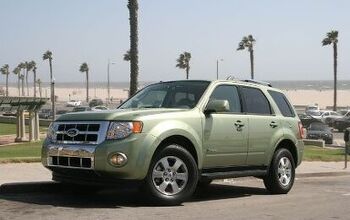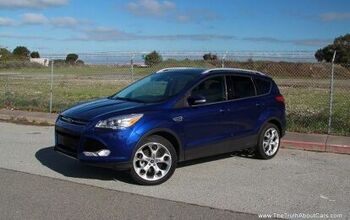Review: 2009 Ford Escape
Conceived in a desperate search of EPA credits, the Ford Escape has walked in the shadows of its bigger brothers, Explorer and Expedition. Despite the Escape’s loveless upbringing, it prevailed, providing easy cream on Ford’s SUV gravy [train]. In the last fuel surge, the Escape found favor: a future president escaped his Chrysler 300C for a gas/electric version of the venerable Fordette. In the ongoing clamor for right-sized, fuel efficient vehicles, one would think the Escape’s inner virtue would shine through. Instead, Ford stifled its middle child by birthing a clusterf*ck of overweight CUVs (Edge and Flex). For 2009, the Escape, again, eats from the scraps.
The Escape has never been a standout in its appearance, nor has it ever been regarded unattractive. Functional may be the most apt description. The 2008 model year’s redux boxed-out the boxy CUV, but deprived it of the Ford family’s trademark bold three-bar grille (black sheep anyone?). Taken as a whole, from a distance, the Escape remains a reasonably decent looking vehicle. Closer inspection reveals a busy mish-mash of hapless shapes, indents, grooves and lines that scream “design by committee.” Nobody could agree on what an Escape should truly look like, so everybody got a vote.
Stepping inside reveals a whole new world of dissonance. The 2001-07 vintage interior was an utterly forgettable homage to Ford-of-the-day high-gloss, poorly grained polymers, Chiclet-inspired buttonry, and second-rate upholstery. The 2008’s redesign brought an utterly dismissable homage to Ford-of-today semi-gloss, meagerly-grained polymers, Lego-inspired buttonry, and self-inflicted second-use upholstery made of recycled fibers (no joke). It’s not ugly, but it ain’t right.
First up, the positives: “Ice Blue” instrument backlighting is a welcome improvement over Ford’s puke green of yore (good riddance). The passenger and cargo compartment are equally spacious for its class, and visibility is excellent. Plentiful cubbies and storage bins surround the front occupants. And that’s about it.
On the negative side, the Escape’s center stack’s buttons are tiny and difficult to navigate at a glance. Ergonomics were an after(noon?)thought. To wit: steering wheel controls have no tactile representation, the illumination controls are hopelessly lost below the driver’s knee along with the controls for the cluster-mounted info center, the dead pedal (wait . . . what dead pedal?), and Ford’s on-again, off-again love affair with the seventy-gazillion functions on a singular steering column stalk (thank Holy Dieties the cruise buttons remain on the wheel, unlike GM).
The Escape’s seats lack lumbar support, the rear bench is (un)remarkably flat, and the recycled-fiber cloth upholstery feels like recycled-fiber, minus the cloth. A myriad of plastics are reasonably soft to the touch, but the sheen and graining wouldn’t convince you of it at a glance. In sum, the rectilinear design theme is a continuum of discontinuity.
Enough kvetching. Let’s drive.
Ford’s venerable Duratec 3.0 V6 displacing three liters arrives for ’09 with new twists: a six-speed autobox, electric-assist EPS steering (no pump thus no parasitic losses), and a host of massages and tweaks. The resulting 240 hp (40 hp gain) and 223 lb·ft of torque make for surprising haste in this sprightly 3528 lb trucklette. When [if] the transmission decides to [maybe] grab the right gear [stay tuned . . . ], the Escape rips off 60 mph sprints that seem far faster than the manufacturer’s claim of high-8s. If the Escape’s corporate father bequeathed it nothing else, it’s got balls.
Unfortunately, if you haven’t figured it out by now, the new 6F35 transmission completely neuters the Escape’s go-fasterism. Downshifts are lazy and indecisive. Rolling stops constantly get stuck in second gear, and twice (count ’em: one, two) in my week-long Detroit Escape, the transmission hailed “no joy” and checked out completely. This during some frustrated passing maneuvers on city streets (engine returned to idle speed and transmission took three seconds to reset and contemplate the appropriate gear). Anecdotal evidence suggests that Ford transmission calibrations are no stranger to epic failure.
When underway, the Escape feels chuckable. The limits of adhesion arrive early and often. The Conti tires throw the towel to understeer first, but drop-throttle can quickly correct a push without excessive drama. The bean counters stormed the Brake Systems design offices like the FDIC on any given Friday; the Escape is the first automobile in modern days to actually step backwards in engineering time to drums at the rear. Surprisingly, little effort or feel seems lost. The EPS system features cool new tricks like pull-drift compensation to soak up crosswinds and road crowns. It works, and steering feel does not seem sacrificed (not to imply it was stellar to begin with).
Despite the nits and gripes, my heart forgives the Escape. It’s a victim, not a criminal. A patchwork of misfit pieces, it nonetheless manages to work—no thanks to its negligent parents. In the end, the Escape succeeds how a middle child does: as a scrapper. But for how long?
More by John Holt
Latest Car Reviews
Read moreLatest Product Reviews
Read moreRecent Comments
- SCE to AUX 08 Rabbit (college car, 128k miles): Everything is expensive and difficult to repair. Bought it several years ago as a favor to a friend leaving the country. I outsourced the clutch ($1200), but I did all other work. Ignition switch, all calipers, pads, rotors, A/C compressor, blower fan, cooling fan, plugs and coils, belts and tensioners, 3 flat tires (nails), and on and on.19 Ioniq EV (66k miles): 12V battery, wipers, 1 set of tires, cabin air filter, new pads and rotors at 15k miles since the factory ones wore funny, 1 qt of reduction gear oil. Insurance is cheap. It costs me nearly nothing to drive it.22 Santa Fe (22k miles): Nothing yet, except oil changes. I dread having to buy tires.
- AZFelix 2015 Sonata Limited72k when purchased, 176k miles currentlyI perform all maintenance and repairs except for alignment, tire mounting, tire patching, and glass work (tint and passenger left due to rock hit). Most parts purchased through rockauto.com.Maintenance and repairs during three years of ownership:Front rotors and all brake pads upgraded shortly after purchase.Preparing for 17th oil change (full synthetic plus filter c.$50), one PCV valve.Timing & accessory belts, belt tensioner.Coolant full flush and change.Fibrous plastic material engine under tray replaced by aftermarket solid plastic piece $110.One set of tires (c.$500 +installation) plus two replacements and a number of patches due to nails, etc. Second set coming soon.Hood struts $30.Front struts, rear shocks, plus sway bar links, front ball joints, tie rod ends, right CV axle (large rock on freeway damaged it and I took the opportunity to redo the rest of items on this list).Battery c.$260.Two sets of spark plugs @ $50/set.Three sets of cabin and engine filters.Valve cover gasket (next week).Averages out to c.$1400 per year for the past three years. Minor driver seat bolster wear, front rock chips, and assorted dents & dings but otherwise looks and drives very well.
- 3-On-The-Tree 2014 Ford F150 Ecoboost 3.5L. By 80,000mi I had to have the rear main oil seal replaced twice. Driver side turbo leaking had to have all hoses replaced. Passenger side turbo had to be completely replaced. Engine timing chain front cover leak had to be replaced. Transmission front pump leak had to be removed and replaced. Ford renewed my faith in Extended warranty’s because luckily I had one and used it to the fullest. Sold that truck on caravan and got me a 2021 Tundra Crewmax 4x4. Not a fan of turbos and I will never own a Ford again much less cars with turbos to include newer Toyotas. And I’m a Toyota guy.
- Duke Woolworth Weight 4800# as I recall.
- Kwik_Shift_Pro4X '19 Nissan Frontier @78000 miles has been oil changes ( eng/ diffs/ tranny/ transfer). Still on original brakes and second set of tires.





































Comments
Join the conversation
I have since purchased a 2009 Escape. I love this car. Great gas mileage, handling and great finish and fit. Before I purchased looked and drove almost every car in the segment. 4 cyl engine is fine, tagged to the 6 speed trasmission. Great car for the money.
I owned an 03 Escape, 4cyl, 5-speed. I opted for the 5-speed, because at the time, the auto had a goofy column shift, and I figured the mileage would be better with the stick. The stick also gave the little Escape a nice basic feel. Unfortunately, the 5-speed, or rather the clutch used with the 5-speed, ended up being a deal breaker for me. The clutch suffered from horrible chatter that worsened when the weather was wet or overly humid. Otherwise, the Escape was one of my favorite vehicles, and I will most likely purchase another (after my current car is used up). I found it to be perfectly reliable (I drove it over 90K miles), fun to drive (the front wheel drive, 4 cylinders have a light, balanced feel to them). When mounted with dedicated snow tires, my Escape provided enough traction to allow me to go anywhere with confidence. I loved the cargo carrying ability, and when my roadtrips turned into real journeys, I never hesitated to pull over, put down the rear seats, and sleep (like a baby). Honestly, if it wasn't for the MADDENING clutch chatter, I'd still have that car...